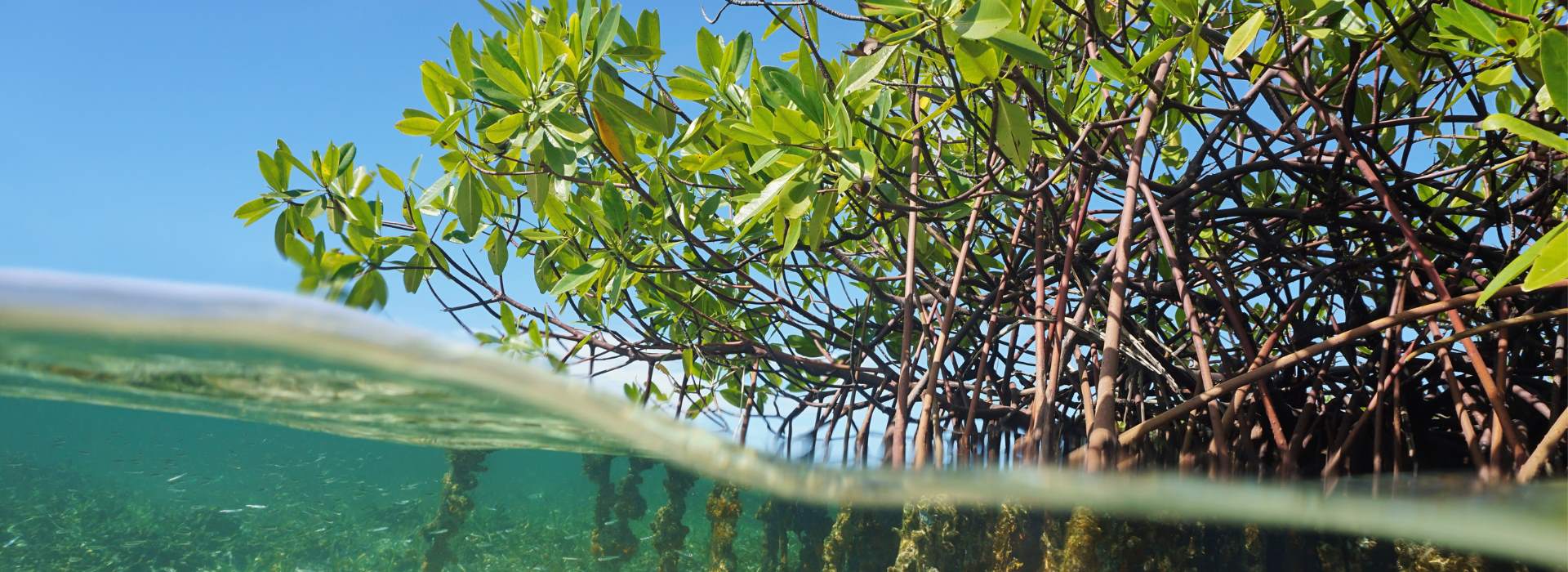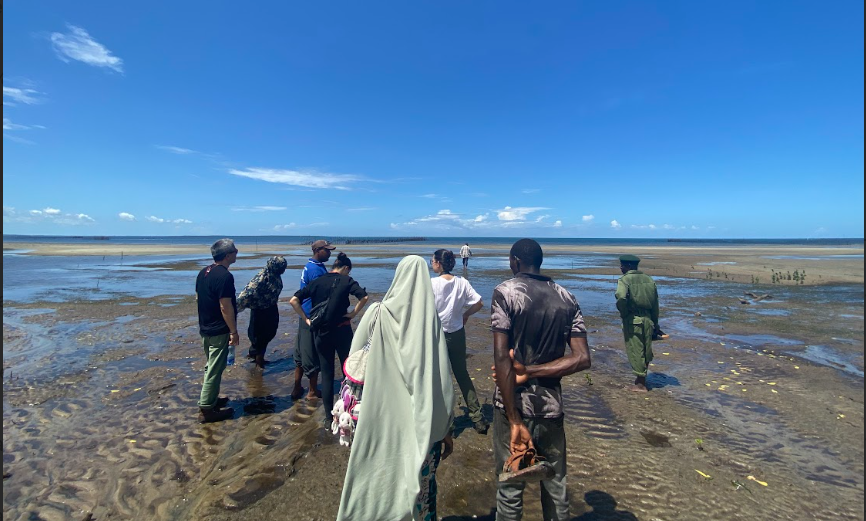5 ways to propel inclusive climate action
September 17, 2024 | By Jason M. Lo Hog Tian, Aisha Shafaqat, Safaa Yaseen and Peter Zhang
A swampy thicket of twisted roots and waxy green leaves gnarl the coastline in southern Kenya. The mangroves, with their riot of brown boughs dipping in and out of the aquamarine water of the Indian Sea, resemble a mysterious fairy-tale illustration. Indeed, they do belie a secret: Mangrove forests are carbon sinks, meaning they absorb carbon dioxide from the atmosphere, capturing 10 times more carbon than regular forests.
In 2012, the coastal villages of Gazi Bay tapped into this natural resource to create the world’s first voluntary mangrove restoration carbon credit project, Mikoko Pamoja. A little farther south in 2019, the tiny town of Vanga established a similar ecosystem along its shores, the Vanga Blue Forest. Both communities managed to reduce carbon emissions while replenishing the marine life so vital to their fishing-dependent economies and selling carbon credits to large companies. These “blue economy” restoration and conservation projects have helped fuel a rise in prosperity in Kenya.
From food and water security to safe, secure housing, climate change disproportionately affects populations that are hardest to reach in the world — those underserved for geographic, administrative or social reasons. Many of these people, however, have shown ingenuity in their response to changing habitats and economic challenges by developing innovative solutions that offer lessons for addressing climate challenges at scale.
It was the creativity of both mangrove projects that caught the eye of Reach Alliance. The organization was founded in 2015 as a partnership between the University of Toronto’s Munk School of Global Affairs & Public Policy and the Mastercard Center for Inclusive Growth to study examples of development strategies for climate-vulnerable communities around the world. The alliance now includes other universities also seeking examples of critical interventions that help far-flung and/or impoverished communities deal with climate change.

The Reach Alliance team visits the Vanga Blue Forest mangrove restoration site in Kenya, which reduces carbon emissions while replenishing marine life vital for the local fishing communities. (Photo courtesy of Reach Alliance)
Throughout their quest, they spotted five key factors for boosting inclusive climate resilience in vulnerable communities: program sustainability, repurposing existing technology and resources, local ownership, appropriate incentives and a network of partnerships.
Program sustainability has been crucial to Kenya’s success. Mikoko Pamoja and Vanga Blue Forest have engaged their local communities in restoring thousands of mangroves — which also protect villagers against extreme weather events. As a result, local Kenyans gain a new a source of income that they invest back into their communities, thus contributing to the development of sanitation, education, health and environment in their own neighborhoods. Creating and maintaining this virtuous cycle that sustains a program through consistent community development ensures the long-term success of an intervention.
In investigating other case studies in Mongolia, the Philippines, Vanuatu and India, Reach Alliance uncovered four additional key factors in climate response strategies:
Leveraging existing technology and resources
Nomadic Mongolian cattle herders are, by their very way of life, among the hardest communities to reach. Without electricity, the herders roam the vast countryside with no connection to the outside world, burning candles for light and raw coal for warmth in their yurts. Since 2000, the Renewable Energy for Rural Access Project has delivered 100,000 portable solar home systems, or SHS, to provide electricity to 70% of these herders. Creating a bespoke way to distribute these systems would be costly, so REAP persuaded the soums — government entities, comparable to counties in the U.S. — to become responsible for distributing and tracking recipients.
In areas where the soum structure was insufficient, REAP partnered with private-sector entities to distribute and help maintain the SHS. (Local service providers also sold light bulbs, replacement batteries and television sets ― products complementary to the SHS units.) Leveraging existing SHS technology as well as the infrastructure to distribute them gives nomadic herders access to electricity where otherwise it would be prohibitive due to location and cost.
Local ownership and engagement
The Alliance of People’s Organizations Along the Manggahan Floodway’s Low-Rise Building Project exemplifies how local ownership and engagement enabled the success of a housing project to reach those affected by flooding in metro Manila, Philippines. When Typhoon Ketsana struck Manila in 2009, the communities living in informal but legal settlements around the Manggahan Floodway were washed out, and the government wanted to relocate them outside the city. However, this community-led alliance formed from neighborhoods along the floodway helped to develop the Low-Rise Building Project, which built 15 climate-resilient buildings for a total of 900 units nearby.
Community members were involved throughout the project, and the governance structure fostered participatory decision-making and women-centered leadership. This created a strong sense of ownership of the building process, and community members were empowered to overcome their challenging circumstances to find a housing solution.
Appropriate incentives
The Unblocked Cash Project in Vanuatu, the South Pacific archipelago that is one of the most disaster-prone nations in the world due to the impact of climate change, used blockchain technology to facilitate a prepaid card assistance system: Beneficiaries could purchase goods and services with the card at a network of vendors equipped with mobile phones. The vendors scanned a QR code on the card to transmit the transaction to the blockchain.
This approach provided a dual incentive: It empowered disaster-affected individuals by giving them the autonomy to make their own purchasing decisions, thus respecting their dignity and choice, while simultaneously revitalizing local businesses that suffer in post-disaster economies. This model demonstrated a shift from traditional aid distribution methods toward more sustainable, community-driven recovery processes that can adapt to the increasing challenges posed by climate change.
A network of partnerships
In India, women make up the majority of the agrarian workforce, but they’re underrepresented in leadership roles and have unequal access to land and agricultural inputs like seed and fertilizer. The UPAVAN project conceived by the NGO Digital Green in Odisha, India, targets these rural women with agricultural advisory services found to be 10 times more cost-effective, and with a 21% higher uptake of practices, than traditional extension services. UPAVAN’s suggest can largely be credited to its strong network of partnerships, which included local NGOs, government programs and international research organizations.
Digital Green collaborated with local partners and worked within the existing health and agricultural systems to tailor technological solutions to the specific needs of the community, ensuring that the interventions were culturally appropriate and effectively implemented. The involvement of local health workers and community leaders in the dissemination and training processes helped bridge the gap between technology and its practical application on the ground.
This article represents the views of the Reach Alliance. Jason M. Lo Hog Tian is a Ph.D. candidate at the University of Toronto and a Reach Alliance researcher. Aisha Shafaqat holds a bachelor’s in political science from University of Toronto and is a Reach Alliance researcher. Safaa Yaseen is a medical student at the University of Birmingham and a Reach Alliance researcher. Peter Zhang holds a Pharm.D. and an MBA and is a Ph.D. student at the University of Toronto, a hospital pharmacist, a Business Acceleration Partner at a health tech startup and a Reach Alliance researcher.
